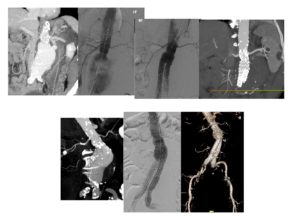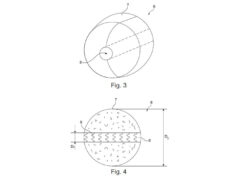
Mo Hamady discusses developments in aortic stent grafts in recent years, and offers a contemplation on the complications associated with endovascular aneurysm repair (EVAR). Despite advances in stent graft technology, operator knowledge, and physician experience in recent years, he writes that the overall long-term survival remains stable, prompting him to encourage interventional radiologists and vascular surgeons to consider the most durable and cost-effective intervention and modality when selecting patients for aortic aneurysm repai.
Aortic stent grafts have been through significant developments over the years in terms of mechanical features and material properties.
These changes have refined the performance of stent grafts such as global deformation, profile, navigability, and conformability. The biggest leap in technology was demonstrated mainly between the first- and second-generation grafts.
Have technological changes influenced clinical outcome?
A large retrospective study, published in the Journal of Endovascular Therapy (JEVT) in 2014, comparing the outcomes of old versus new generation stent grafts, showed lower reintervention rates at five and seven years; 86.6% and 83.6% versus 80.3% and 74.2% (p=0.015) in favour of new stent grafts. Similarly, newer stent grafts had better freedom from late conversion and sac growth >5mm (p=0.0001 and p=0.022, respectively). Lower type 1 endoleak (p>0.07) and less grafts migration (p>0.02) were noted in another study featured in the Journal of Vascular Surgery in 2017, assessing the performance of Endurant and Talent stent grafts (Medtronic).
A French Registry of 176 patients reported on the performance of the second-generation Anaconda EVAR (Terumo Aortic) over five years. Although one third of the studied cohort had hostile neck anatomy, there was higher freedom from aneurysm related re-intervention when compared with the reported results of the Dutch DREAM trial: 78% versus 70%. The Italian Registry for the new generation C3 Gore Excluder stent graft of more than 460 patients, all followed for 10 years and treated as per the instructions for use (IFU), showed quite high freedom from reintervention (80%) and freedom from stent-related complications (88%).
The improvement in cloth material and refinement in stent structure have influenced the durability outcomes. Type III endoleak was studied in a large retrospective study of more than 900 patients, published by in the Journal of Vascular Surgery in 2017. Almost 50% reduction of this serious endoleak was noted in the third generation grafts when compared to the first and second generations.
This technological development has been accompanied by a growth in operator knowledge and experience. There is consistent observation in the literature that the use of stent grafts within IFU is accompanied by reduction in early type 1 endoleak, early reinterventions, and late death. In one retrospective study of more than 600 patients, among several other studies, published in the Journal of the American College Surgery in 2016, it was documented that early and late type 1 endoleak, early reintervention, and late death were all significantly higher in the cohort of patients treated outside IFU, despite very high initial technical success. It is alarming that this kind of practice is still widespread and there is a real possibility that the reported results are actually undermining the technological development in this field.
The concept of relation between neck diameter and durability is gathering momentum. Several studies have shown that the smaller the neck diameter, the better the overall results are. The GREAT registry collects data from real life patients treated with C3 Gore stent graft. A study of more than 1,600 patients published in 2018 in the Journal of Vascular and Endovascular Surgery showed that neck diameter of ³25mm was significantly associated with lower freedom from type 1A endoleak, lower freedom from aortic reintervention, and lower freedom from primary composite end point at five years. It is however inconsistent in the literature what the diameter threshold is that defines the desired neck.
Despite the great investment in this technology, the overall long-term survival remains stable regardless of the technology or stent manufacturer. This is perhaps an expected finding in a pathology that frequently presents with several other co-morbidities. This observation should prompt interventional radiologists and vascular surgeons, when selecting patients and/or treatment modality, to consider the most durable and cost-effective intervention.
Future developments
Several outstanding issues are yet to be studied. The new stent designs and new adjuncts such as endostaples should be properly appraised. The optimum neck diameter, together with ideal length (fenestration versus standard EVAR), should be included in the long-term risk-benefit assessment. A reliable and sensitive follow up tool, beyond CT and ultrasound, will be welcomed for the life-long needed surveillance.
Mo Hamady is a consultant interventional radiologist at Imperial College, London, UK, the training programme director for Interventional Radiology at London Health Education England (HEE), and is secretary of the British Society of Interventional Radiology (BSIR). EVAR












